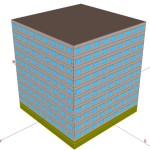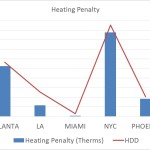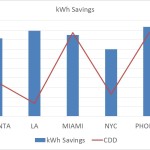
Figure 1 – Typical Shell Building
Can degree-days be used to determine where energy efficient window film should be considered? If so, how many cooling degree-days (CDD) are ‘enough’ to justify consideration of window film? Also, what about the heating penalty from window film and the heating degree-days (HDD) for the location under consideration? Is it enough to see a location like Sacramento where CDD are relatively low? What about New York City where HDD are 4 times CDD1 – will that alone make it a bad candidate?
The purpose of this blog is to illustrate the shortcomings of this type of estimation using CDD and HDD as the go/no-go gauge for energy efficient window film. In fact, I will use another type of estimation to make this judgment which leaves it up to the reader to determine whether one form of estimation is better than another. The estimation we will use to make the comparison is the eQuest energy simulation modeling software for a 10-story hotel with dual-pane clear glass and 30% window-to-wall ratio. The HVAC system is a 4-pipe fan coil with chilled water and hot water (chilled water COP=4.5 and hot water heating efficiency = 85%).
Results
When considering HDD, Figure 2 below shows significantly similar results between HDD and eQuest heating penalty. This means, as one would expect, in cities where significant space heating is required the application of solar control window film produces a proportional heating penalty. In this case, for this data set, HDD was a good predictor of heating penalty
[1] Degree-Day data from http://www.ncdc.noaa.gov/ol/climate/climateproducts.html
Figure 2 – HDD and Heating Penalty

Figure 3 – CDD and Cooling Savings
But what about CDD? Does CDD correlate well with cooling (kWh) savings? As you can see in Figure 3 below, CDD does not correlate well with simulated savings from eQuest.
CONCLUSIONS
First, it should be mentioned that these were the first five (5) cities chosen for comparison – they were not cherry-picked to tell a particular story.
To be sure, the small size of this data set does not allow for the conclusion that heating penalty can be predicted reliably by HDD. This data set may show a trend but it is too early to make a conclusion.
However, this small data set is enough to show that cooling savings cannot be predicted by CDD.
What also cannot be concluded from this data is why HDD has a better correlation to heating penalty than CDD has with cooling savings, although there are some reasonable possibilities:
- a large part of heating losses in winter is conduction and HDD is related to conduction since conduction is proportional to delta-T between inside and outside
- cooling savings is complex because in addition to conductive heat transfer (like HDD), we have to consider radiative heat transfer (solar radiation) in cooling when the sun angle and solar heat gain are high
What other considerations do you think explain the difference in these Figures?


